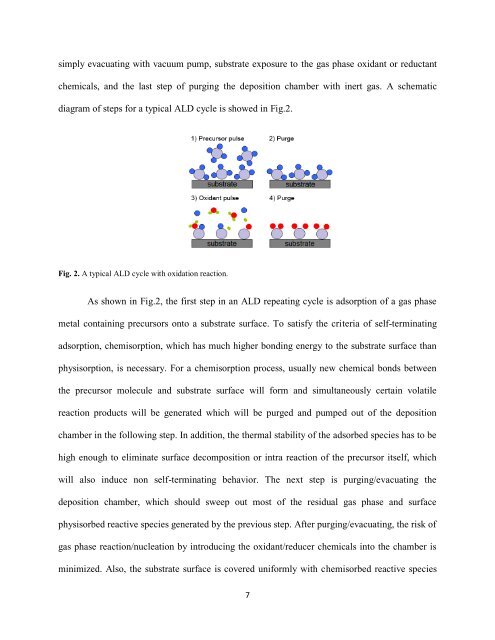CHEMICAL VAPOR DEPOSITION OF THIN FILM MATERIALS FOR ...
CHEMICAL VAPOR DEPOSITION OF THIN FILM MATERIALS FOR ...
CHEMICAL VAPOR DEPOSITION OF THIN FILM MATERIALS FOR ...
You also want an ePaper? Increase the reach of your titles
YUMPU automatically turns print PDFs into web optimized ePapers that Google loves.
simply evacuating with vacuum pump, substrate exposure to the gas phase oxidant or reductant<br />
chemicals, and the last step of purging the deposition chamber with inert gas. A schematic<br />
diagram of steps for a typical ALD cycle is showed in Fig.2.<br />
Fig. 2. A typical ALD cycle with oxidation reaction.<br />
As shown in Fig.2, the first step in an ALD repeating cycle is adsorption of a gas phase<br />
metal containing precursors onto a substrate surface. To satisfy the criteria of self-terminating<br />
adsorption, chemisorption, which has much higher bonding energy to the substrate surface than<br />
physisorption, is necessary. For a chemisorption process, usually new chemical bonds between<br />
the precursor molecule and substrate surface will form and simultaneously certain volatile<br />
reaction products will be generated which will be purged and pumped out of the deposition<br />
chamber in the following step. In addition, the thermal stability of the adsorbed species has to be<br />
high enough to eliminate surface decomposition or intra reaction of the precursor itself, which<br />
will also induce non self-terminating behavior. The next step is purging/evacuating the<br />
deposition chamber, which should sweep out most of the residual gas phase and surface<br />
physisorbed reactive species generated by the previous step. After purging/evacuating, the risk of<br />
gas phase reaction/nucleation by introducing the oxidant/reducer chemicals into the chamber is<br />
minimized. Also, the substrate surface is covered uniformly with chemisorbed reactive species<br />
7

















